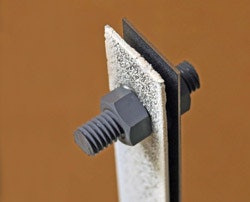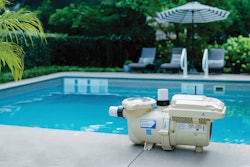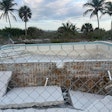
Ever find little white flakes on the bottom of the pool near the return? These are little pieces of calcium carbonate that have broken off and traveled through the system. If it's a saltwater pool, they very likely came from the electrolytic chlorine generator (ECG). They formed around the blades or plates in the ECG and then chipped off, and were swept through the piping and into the pool. They may seem like a minor irritation, but mineral deposits are the No. 1 enemy of salt chlorine generators.
Finding scale in pools is nothing new; we've seen it from the beginning of the industry. Almost any vessel that contains water, whether it's a pool, spa, boiler, hot water heater or even a saucepan, will become encrusted with minerals at some point, but the problem takes on a special significance in pools with salt chlorine generators.
Scale is one of the most common and serious challenges in saltwater pool maintenance, partly because it typically forms first on the cell plates inside the ECG where it can remain undetected until the problem is well advanced. Once it has formed, it hampers the effectiveness and life span of the ECG, which wastes the customer's money and can lead to premature replacement.
Salt chlorine generators, by their nature, create ideal conditions for the formation of scale, and despite the efforts of engineers to design these systems to prevent the scourge, it continues to cause damage and early failure in ECGs on a wide . . . scale.
Eternal Annoyance
The history of scale is as old as hot, hard water; assuming the laws of chemistry have been evenly enforced throughout the ages, scale must have coated the cooking pots of Roman legions and been an annoyance to Nebuchadnezzar's chef.
Scale is simply the term for minerals falling out of solution and forming mineral deposits. Calcium is the mineral with which most people are familiar, but other ones common in pools are phosphates, silicates and sulfates.
It's a natural, and to some extent, an inevitable process. It has become a greater concern in recent years, however, due to the fact that it degrades the growing number of chlorine generators.
Before salt systems became popular, the pool heater was the most likely location for scale to form in any pool system, because it's hot there, and scale loves heat. But since then we've added a rival for scale's clinging affection — the ECG. It's hot, too, and it has the added attraction of an enticing chemical environment of extremely high pH.
That high pH is a result of the chlorine production process, says Zach Hansen, technical services engineer, BioLab, Marietta, Ga.
"The generator is converting the salt, sodium chloride (NaCl), into chlorine for the pool and a by-product of that process is sodium hydroxide (NaOH), which drives the pH up," he says. "And that creates conditions very favorable for the formation of scale in the cell."
It should be mentioned, he adds, that due to that steady production of NaOH, the pool in general is always drifting upward in pH. Over time, if the overall pool pH is not maintained within limits, there will be issues — among them scaling in the entire pool, not just the ECG.
Another problem contributing to the formation of scale in the ECG is the heat generated by the electrolytic process. Most substances, like sugar for instance, dissolve better in hot water, but calcium is one of nature's anomalies. The hotter the water, the more it tends to drop out of solution and form a deposit.
This means that any place where you have heat, like the ECG or a heat exchanger, you're going to get scale there first. These factors — heat, high pH and minerals —combine to create something of a "perfect storm" of scale formation inside the tight confines of the ECG.
Tight Quarters
Sharing that space with all that sodium hydroxide, heat and minerals are the titanium plates used to produce the chlorine as saline water passes between them. Each plate has a baked-on coating of ruthenium oxide to enhance its conductivity — so the current will flow efficiently, and also to protect the titanium.
In this confined space of ideal scale-forming conditions, calcium carbonate builds up on the surface of the plates, notes Bob Harper, pool industry veteran and general manager of Pristiva, a salt manufacturer owned by Compass Minerals. Heat continues to be produced by the titanium plates as this occurs — heat that is normally carried away by the flow of water — "but as the scale builds up on the blade, it forms a layer between the water and the blade and acts like a really good insulator. So it's now holding the heat in. The water is coming in contact with the scale, not the blade, so the whole system is running hotter."
As this heat builds up, Harper says, the baked-on layers of Ruthenium Oxide, crucial to the ECG's function and which determine the life of the unit, can start to loosen up and even slough off, thus shortening the life of the unit.
At the same time, the scale interferes with chlorine production, reducing the efficiency of the unit, which may result in the user running it harder, thereby increasing scale production, further reducing production, in a vicious cycle of diminishing performance and ECG destruction.
The Old Switcheroo
The problem of scale in the ECG has certainly not escaped the notice of engineers at salt cell manufacturing plants. Scale only forms on the anode or positive plate, so they've developed a system of reversing the polarity of the plates, periodically switching the anode and cathode, which helps slow scale formation dramatically.
"It's a timed event," Harper says, "built into the software of the unit; some do it every two hours, some do it every three hours. Some do it every four hours."
Harper notes that when the positive current stops flowing through the anode and is switched to the other side, the majority of the scale is repelled and sloughs off the plate, allowing the water will carry it away. "It's the source of a phenomenon that many pool owners and service techs have noticed over the years, where they observe small white flakes next to the return on a saltwater pool. Those white flakes are the scale that has just sloughed off a titanium ECG plate as the unit reversed polarity. Unfortunately, not all of the scale sloughs off. It's a process of diminishing returns. Each time it happens it becomes a little less efficient. So a little bit of scale remains on the plates."
Release Your Inhibitions
Another preventative measure is the use of products suitable for use in saltwater pools. This includes high-quality salt that does not contain mineral impurities, which can add to the scaling problem.
"We also recommend the use of scale-inhibition products," Hansen says, "which help prevent the formation of scale through sequestration of calcium."
The distinction between traditional sequestration products and saltwater pool products is important, he adds. "There are products that are generally used in pools to sequester minerals but the salt chlorine generator makes it a unique situation because of the conditions within the cell, the high chlorine levels, high pH, and heat. So homeowners and service techs need to use a product for scale that is specifically designed to withstand those aggressive conditions inside the cell.
"There are products that you could use that are fine for use in a regular swimming pool, that won't work in a pool with a chlorine generator cell. They won't withstand those conditions."
Signs Of Scale
Despite these preventative measures, scale will develop over time in the ECG, and that fact must be firmly entrenched in the mind of anyone caring for a saltwater pool. It must be cleaned out to restore proper function. But how can a service tech or homeowner tell that it's time to tidy up the cell?
"The easiest way is visual inspection of the ECG," says Harper, "But you might see some other tell tale signs before that. You might see those white flakes in the returns when it reverses polarity — if you see those flakes with more regularity and intensity, you're seeing scale enter the pool — that would be a good indication of a scale problem.
"Another sign of scale is the ECG isn't producing chlorine the way it used to. That can be tough sometimes, because there are a lot of factors involved. The rate of chlorine consumption changes due to water temperature, bather load, rain and wind, etc. But if all things seem equal, you've got about the same weather conditions and bather load, and the chlorine keeps reading too low, you have to keep cranking your ECG up, or maybe you're not getting any chlorine production at all, and all the other lights on the unit look good — you're salt level, your current looks good — that could be a good sign that maybe this thing's gotten dirty and it's time to clean it up."
At this point, open up the unit and have a look. A visual inspection should be done periodically anyway, in accordance with the ECG's manual. Hansen says that most service techs with experience are on the lookout for scaled up ECGs, but homeowners may be unaware of the issue.
"The manufacturers have been pretty good about training service people about inspecting and cleaning cells," he says. "It's the individual homeowners, however, who may be unaware of the problem. They've contracted a builder to construct their pool, and whomever sells them the electrolytic equipment tells them it's great, there's no maintenance, there's nothing you have to do, and they don't have that knowledge and education like the service pro does, that there are things you need to do to maintain the equipment."
The cleaning procedure is fairly simple, although it requires acid, which always requires care in handling. As always, consult the manual, which is written under the guidance of the engineers that built the thing.
In a typical cleaning, Harper says, "You would remove the unit (after turning off the pump of course), let the water drain down, and then visually inspect it. And assuming you can see some scale in there, the first thing you would do is take a low pressure hose and rinse off the plates, trying to dislodge any scale you can. You don't want to damage the plates with a high-pressure rinse. And remember this is an electrical component.
"And then, you would soak the unit in a solution of water and muriatic acid — typically a five-to-one or four-to-one solution. Everyone's got his or her own views on this. I favor the weaker, five-to-one version. But I've seen some techs that go all the way up to a three-to-one solution. The reason I recommend the milder solution is due to the Ruthenium-oxide coating on the plates. Every time you acid-wash them, it removes some of that coating, which dramatically shortens the life of the cell."
Persistent Myths
Like any product, the ECG requires maintenance to function properly, and it requires an understanding of what processes and factors will shorten its service life. What has made this particular piece of technology a little bit unusual is the myth that developed around it and still survives in some quarters, that it is maintenance-free.
Bringing customer expectations in line with reality is the industry's duty.
Comments or thoughts on this article? Please e-mail [email protected].









































